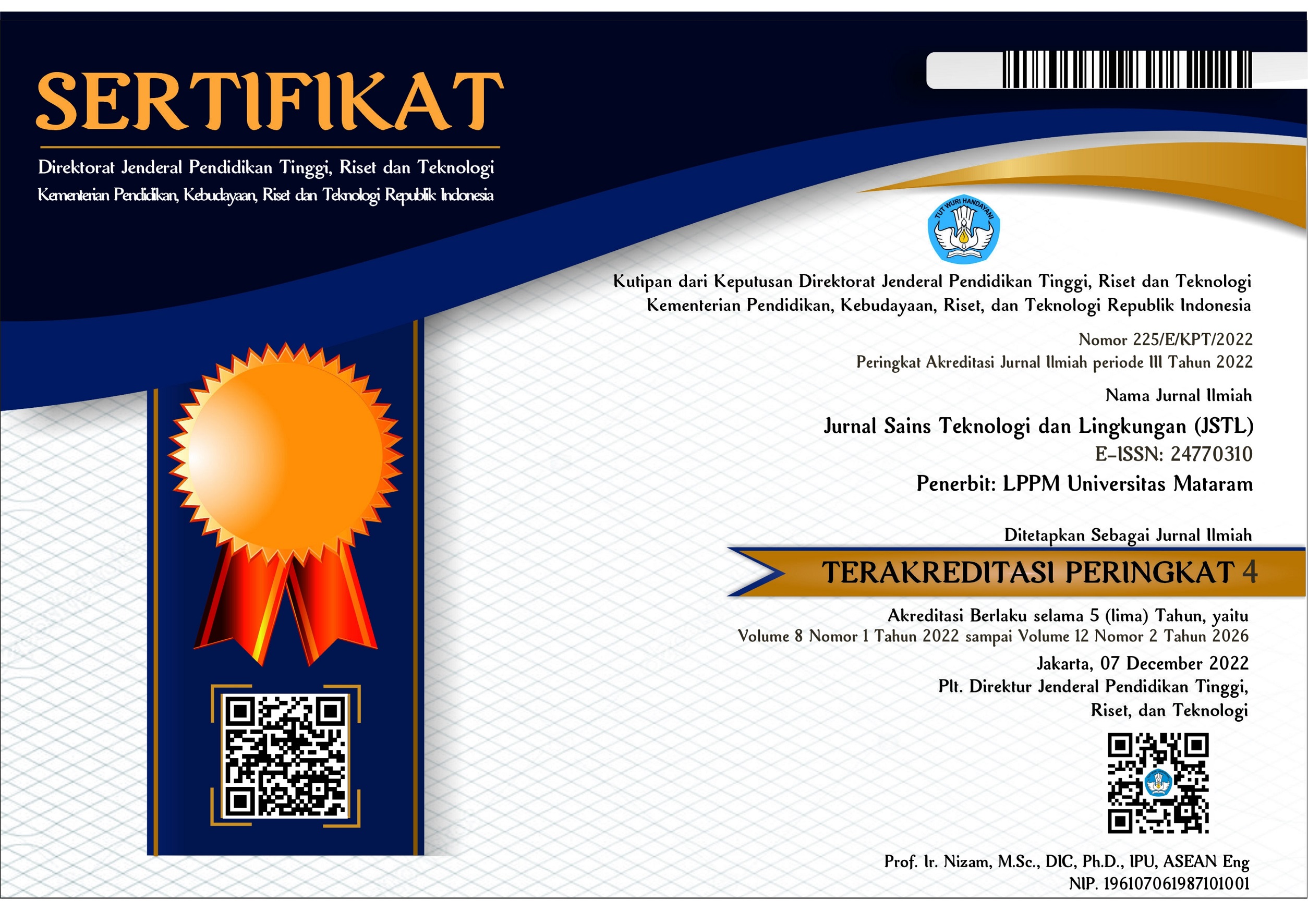Serapan Hara N, P, K dan Pertumbuhan Tanaman Jagung Pada Berbagai Dosis Pupuk Anorganik dan Organik di Tanah Inceptisol
DOI:
https://doi.org/10.29303/jstl.v0i0.245Keywords:
nutrient, uptake, growth, fertilizer, CornAbstract
The use of inorganic fertilizers has an important role in increasing plant growth and production. But it also causes various problems such as decreasing soil organic matter, soil acidity, soil degradation, nutrient imbalance and increasing environmental pollution. Therefore, it needs to be balanced with the provision of organic fertilizers. A field experiment was conducted to study the effect of application of various doses of inorganic and organic fertilizers on N, P, K nutrient uptake and maize plant growth. The experimental design used was a randomized block design arranged in a factorial manner consisting of two factors. The first factor is the dose of inorganic fertilizer (A): 0, 150 and 300 kg ha-1 phonska and the second factor is organic fertilizer plus (P): 0, 10, 20 tons ha-1. The two factors were combined and each treatment combination was repeated three times. The data obtained were analyzed by analysis of variance at the 5% level of significance. The results showed that there was no interaction between the application of inorganic and organic fertilizers on the growth and nutrient uptake of N, P and K. However, the application of inorganic and organic fertilizers had a significant effect on all tested agronomic traits except for plant height. Nutrient uptake of N, P and K also increased significantly due to the application of inorganic and organic fertilizers. The balance of inorganic and organic fertilizer application increases the availability of nutrients as well as the uptake of N, P, and K nutrients by maize plants.References
Aleel, K.G. 2008. Phosphate Accumulation in Plant. Signaling. Plant Physio, 148:3-5.
Badan Pusat Statistik. 2015. Luas panen, Produktivitas dan Produksi Jagung Manis Menurut Provinsi. http://www.bps.go.id , 28/11/2008.
Brady, N, C., Weil, R. R. 2002. The nature and Properties of Soils. 13th edition. Pearson Education, New Jersey.
Ganorkar, R. P. and Chinchmalatpure, P. G. 2013. Physicochemical Assessment of Soil in Rajura Bazar in Amravati District of Maharastra (India). International Journal of Chemical, Environmental and Pharmaceutical Research : 4(2&3), 46-49.
Gardner, F. P. Pearce, R. B. dan Mitchell R. L. 1991. Fisiologi Tanaman Budidaya. UI. Press.
Glaser, B., Lehmann, J. Zech, W. 2002. Ameliorating Physical dan Chemical Properties of Highly Wethered Soils in the Tropics with Charcoal. A Review. Biol. Fertil Soils. 35 : 219-230.
Goldsworthy, P. R. dan Fisher, N. M. 1992. Fisiologi Tanaman Budidaya Tropik. Gadjah Mada University Press. Yogyakarta.
Gupta, P. K. 2004. Soil, Plant, Water and Fertilizer Analysis. Shyam Printing.
Hardjowigeno, S. 2003. Ilmu Tanah. Akademika Presindo. Jakarta.
Haynes, R. J. and Naidu, R. 1998. Influence of Lime, Fertilizer and Organic Manure on Soil Organic Matter Application and Soil Physical Condition. Nutr.Cycl. Agroecosyst. 51: 123-137. Kumar, D. Jhariya, N. A. 2013. Nutritional, Medicinal and Economical Importance of Corn: A Mini Review. Research Journal of Pharmaceutical Sciences, 2, 7–8. Press. London. UK.
Lehmann, J. 2007. Bio-energy in the Black. Front Ecology Environment 5: 381-387.
Lehmann, J. and Joseph, S. 2009. Biochar for Environmental Management. Earthscan. UK.
Laird, D.A. 2008. The Charcoal vision: a Win-Win-Win Scenario for Simultaneously Producing Bioenergy, Permanently Sequestering Carbon, While Improving Soil and Water Quality. Agron. J. 100:178-181.
Liu, E., Changrong, Y., Xurong, M., Wenqing, H., So, H.B., Linping, D., Qin, L., Shuang, L., Tinglu, F. 2010. Longterm Effect of Chemical Fertilizer, Straw, and and Manure on Soil Chemical and Biological Properties in Northwest China, Geoderma 150: 173-180.
Made. 2010. Respons Berbagai Populasi Tanaman Jagung Manis (Zea mays saccharata Sturt.) Terhadap Pemberian Pupuk Urea. J Agroland. 17(2):138-143.
Marchner, H. 2002. Mineral Nutrition on Higher Plant. Academi Press. 2nd edition. Harcourt Jovanovich Publisher. London.
Mirwandono, E., Sitepu, M. Wahyuni, T. H. Hasnudi, N., Siregar, G. A. W. and Sembiring, I. 2018. Nutrition Quality Test of Fermented Waste Vegetables by Bioactivator Local Microorganisms (MOL) and Effective Microorganism (EM4). International Conference on Agriculture, Environment, and Food security. IOP Conf. Series: Earth and Environmental Science 122: (2018) 012127.
Mulyati dan Lolita, E.S. 2006. Pupuk dan Pemupukan. UPT Universitas Mataram Press. Mataram.
Purwono dan R. Hartono. 2008. Bertanam Jagung Unggul. Penebar Swadaya. Jakarta.
Rubatzky, V.E., and Yamaguchi M.1995. Sayuran Dunia : Prinsip, Produksi, dan Gizi. Jilid ke-1. Herison C, Penerjemah. Bandung (ID): ITB Pr. Terjemahan dari: World Vegetables: Principles, Production, and Nutritive Values.
Rubatzky, V.E., and Yamaguchi M. 1998. Sayuran Dunia: Prinsip, Produksi, dan Gizi. Herison C, Penerjemah. Bandung (ED): ITB Pr. Terjemahan dari: World Vegetables: Principles, Production, and Nutritive Values.
Salisbury, B.F. dan Ross W.C. 1995. Fisiologi Tumbuhan. Alih Bahasa oleh Diah R. Lukmana dan Sumaryono, ITB Bandung. 343 Hal.
Sandhu, K. S., Singh, N., and Malhi, N. S. 2007. Some Properties of Corn Grains and Their Flours I: Physicochemical, Functional and Chapati-making Properties of Flours. Food Chemistry, 101: 938–946.
Sitompul, S. M., dan B. Guritno. 1995. Analisa Pertumbuhan Tanaman. Gadjah Mada.
Sutanto, R. 2002. Penerapan Pertanian Organik: Pemasyarakatan dan pengembangannya. Kanisius Publisher. Yogyakarta. ISBN 9792101. 219h,
Tracy, W. F. 1994. Sweet Corn. In: A. R. Halleuer (Ed.) Specialty Corns. USA: CRC Press Inc.
Warisno. 2007. Jagung Hibrida. Kanisius. Yogyakarta. 43-56 h.
Woolf, D. 2008. Biochar as a Soil Amendment : A Review of the Environmental Implication. http://orgprints.org/13268/1/Biochar_as_a_Soil_Amendment_a Review pdf. Retrieved 2 October 2008.
Yamato, M., Okimori, Y., Wibowo, I.F., Anshioro, S. and Ogawa, M. 2006. Effects of Application of Charred Bark of Acacia Mangium on the Yiled of Maize, Cowpea and Peanut, and Soil Chemical Properties in South Sumatra, Indonesia. Soil Sci. Plant Nutr., 52:489-495.



1.png)











